Garden planning can be intimidating.
Learning to trust our seeds (and ourselves) is the work (and play!) of a lifetime and I’m honored to share everything I’ve learned about gardening and garden planning with you!
First, you should know: There are as many ways to plan a garden as there are gardeners, so Friends…
Here is what I ask of you:
~ learn all you can from gardeners you love (I’m honored to be among them!)
~ experiment with curiosity and joy
~ share everything you learn with everyone you can
…because we all grow more when we share more!
Second, here are:
A Few Key Questions in Garden Planning
to get you started, explored in greater depth in the video above and in the words below:
1. What is most important for me to grow? Sow what you love!
2. When is best for me to start growing? Depends if you’re sowing indoors or outdoors and also if the plant is frost hardy or not! Enjoy our calendars and charts below.
3. Where is best for me to grow? The richest well-drained soil with full sun you can find.
4. How many seeds should I sow? 2 to 3 per soil block, cell or anywhere else you’re direct sowing. Anticipating yield is a guess at best, so err on the side of growing less and optimizing your abundance as you begin so you can scale with confidence.
5. How deep and far apart should I sow them? Sow seeds twice their depth and check the side-tab on the back of each packet for spacing details — basically, give them space they’ll need as mature plants right from the start, except for roots who get thinned to mature plant spacing.
6. What are the easiest plants to grow? Most productive per bed foot? Kale, chard and parsley are all super productive and super easy to grow! Bush beans, bush cucumbers and zucchini are also remarkably easy to grow, as are dill, cilantro, sunflowers, cosmos and calendula. In the right soil, carrots, dry beans, kale and tomatoes are impressively productive per bed foot, as well. That is the smallest of nutshells for you!
Now, let’s dive into the nitty-gritty aspects of garden planning.
That being said, it’s difficult to learn to ride a bike by reading, by watching a video. I wish I was there with you, Friends! That’s why we created Fruition’s online Seed Starting Academy which is now free, don’t be shy, because you are not alone and we’ve only just begun!
And Friends, everything I’m sharing in this blog post is the cliff-notes version of what I share in much greater depth in my 40-page book, Rise & Shine: Starting Seeds with Ease, as well as Across the Seasons, our perpetual calendar and garden planner.
What to Sow
Sow what you love, love what you sow.
People share all the time, “I’m just getting into gardening, what should I grow?!” and here’s the thing: We take care of what we love, so sow what you love. Just because kale is easy to grow and super nutritious, don’t plant it if you don’t loveLOVElove it. Granted, homegrown everything is always better than what you’ll find in a grocery store, but nonetheless. Sow what you love and love what you sow!
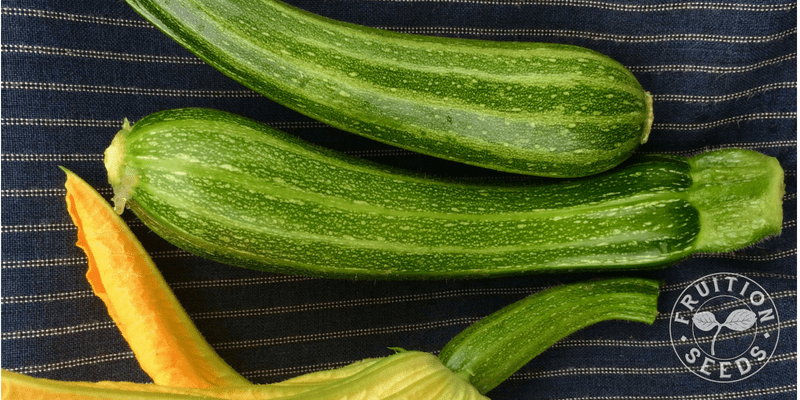
What should you grow? Sow what you love! This is our Cocozelle zucchini, which we love!
When to Sow
Timing is everything. Some plants, like kale, are immensely adaptive and manage to thrive no matter how and when they’re planted. Others, like peppers, are impressively persnickety and if they’re even a little uncomfortable, they ‘pout’ for the rest of the season.
To begin, here is a cliff notes planting calendar we made for Zones 4 through 6 to share! And if you’re in Zone 7 or warmer, simply add two weeks on either end of the growing season for each Zone:
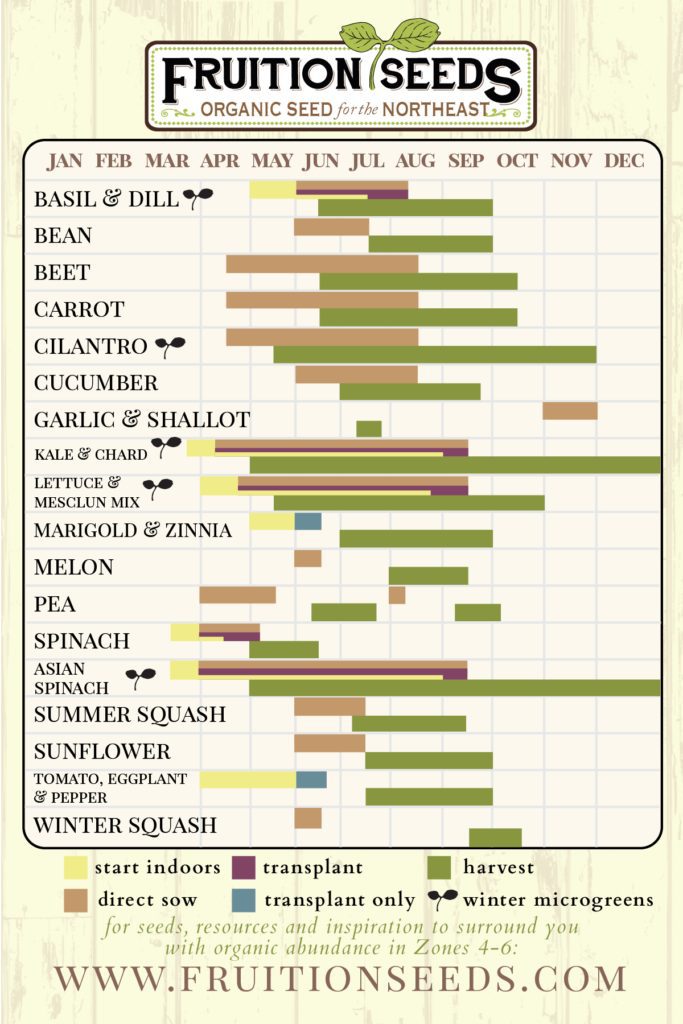
We send this planting calendar out with every order we send, so perhaps you already have it tucked on your fridge. If not, know it will come with your next order! We’ve tucked a full-page version in Rise & Shine: Starting Seeds with Ease and you can also download the digital copy in Fruition’s Growing Library here along with all our garden planning downloads and Growing Guides to surround you with abundance!
And Friends, you’ll also find clues on the back of each of our packets. We’ve made our packets tiny encyclopedias for you, sharing both growing info as well as a handy tab on the side where you’ll find plant spacing after thinning, whether to direct sow or transplant (or both), days to germination and when to sow as well as seeding depth:
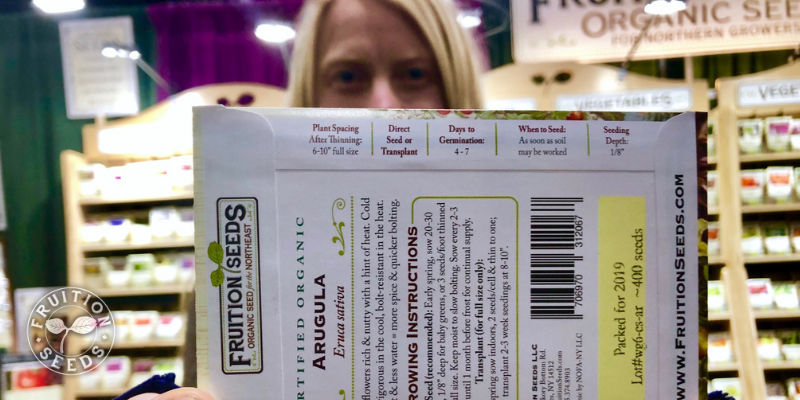
Note the growing info on the side-tab: We’ve made our packets tiny encyclopedias for you!
When to Direct Sow
For the deeper dive, we’ve made you a full-page Direct Sowing Chart, relevant across most growing Zones. This is a simplified version of what we share in our book Rise & Shine: Starting Seeds with Ease as well as our perpetual calendar, Across the Seasons. Take a peek below:
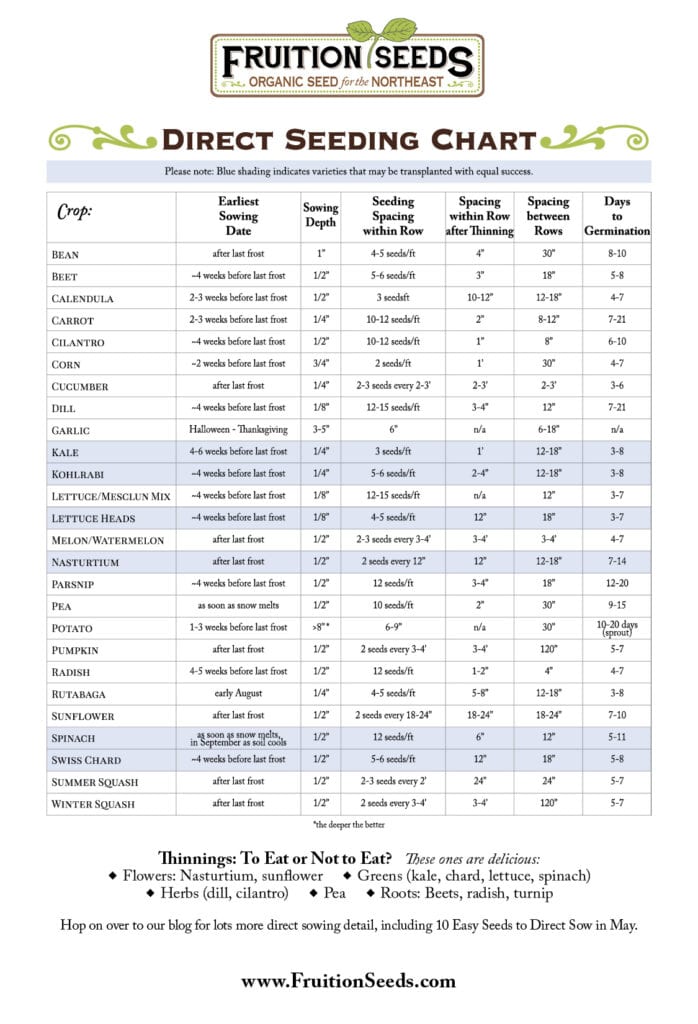
When to Sow Indoors and Transplant Out
It’s counter-intuitive, but plants started too early indoors often get stressed (too little light, too few nutrients) and thus produce later and less abundantly than younger plants that are less stressed.
If you have a great seed-starting set up including a grow light and lots of time to pot up and tend to your tender seedlings, you can start on the earlier side of the planting ranges. If you don’t have a great seed starting set-up, sow later in the planting range and strongly consider only starting seeds of plants that need less than one month in your home, transplanting them out as soon as you possibly can. Without great light (and south-facing windows just don’t count here in the Northeast!), your transplants are more than one month old, they’re likely going to be stressed and less healthy, productive and delicious as a result.
We’ve made you a full-page Direct Sowing Chart, too! She’s relevant in most growing Zones. Take a peek and find in Fruition’s Growing Library here:
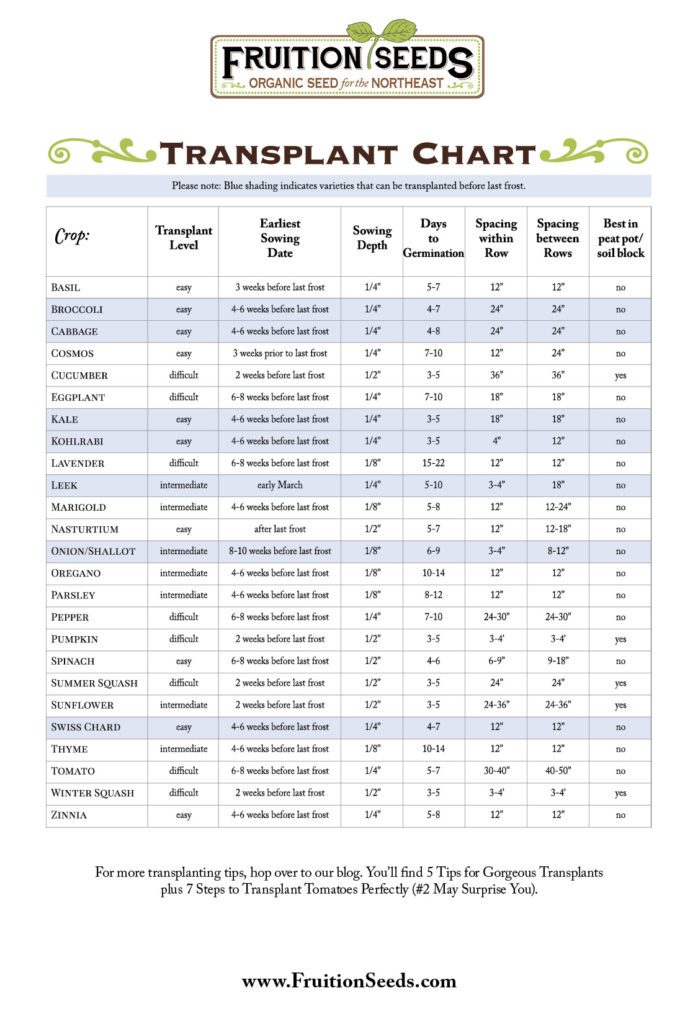
How much to sow?
What an impossible equation to nail exactly, but here are some keys to keep in mind.
Some plants like chard, kale and parsley we can harvest all season. For these plants, we sow 3 to 4 plants per person, sometimes more — but keep in mind we eat *way* more vegetables than most people we know!
Other plants like cilantro and salad mix we sow every 3 to 4 weeks throughout the season so we’ll enjoy a constant harvest. We sow at 2′ of these crops per person, which is a lot of food, so start with less, unless you can commit to taco night every night or every meal with a salad (as we do joyfully)!
Friends, anticipating yield is a guess at best, so I recommend erring on the side of growing less and optimizing your abundance at the beginning so you can scale with confidence.
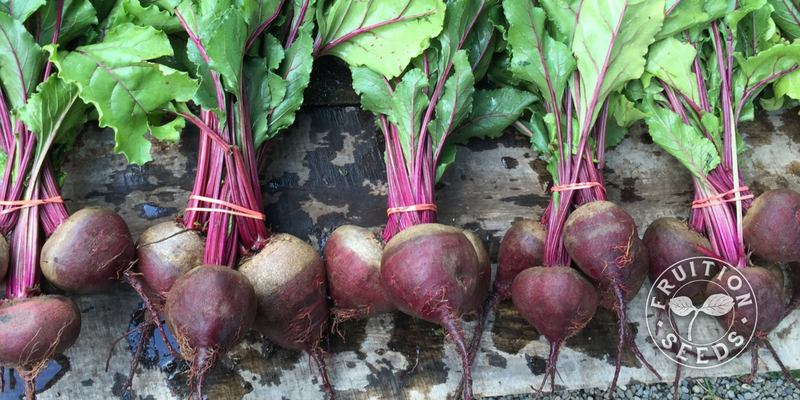
Our friend Sharon sows five feet of beets every 3 weeks from mid-April to mid-August to nourish her family of three. Have fun finding your own patterns of how much to sow for you & your family!
Soil Temperature, Preparation & Fertility
Soil Temperature
In general, if a variety needs warm soil to germinate, you can sow the seed after your last frost confident that the soil has warmed sufficiently. If a variety prefers to germinate in cooler soil, sow it before last frost (April/early May here in Zone 5) or in the fall September/early October. Many crops, like lettuce, kale and beets, germinate in a wide temperature range and may be sown throughout the season. Others, like spinach, are very particular and will only germinate in cool soils. Each packet and the chart below will give you a sense of what to plant when.
As soon as the snow melts and the crocus are blooming, we’re planting peas, spinach, asian spinach, arugula, kale and radish, and who knew, cilantro! Sweet peas, calendula and somniferum poppies are also to plant when the soil is cool.
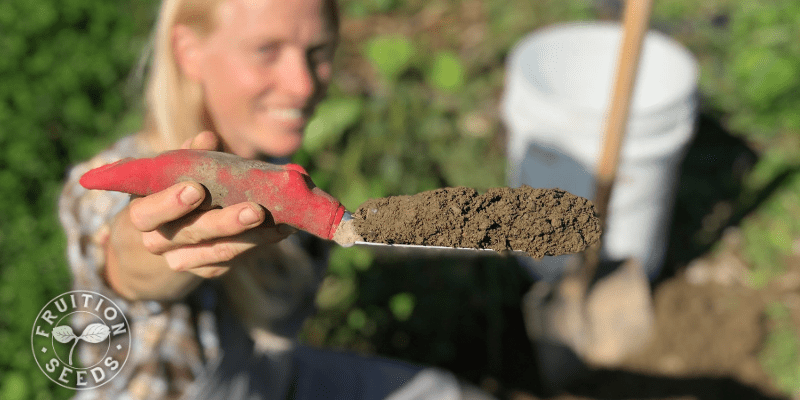
Soil testing is both easy and essential! Enjoy our blog about soil testing here
Soil Preparation
Preparing your garden soil is a complex equation of timing, tools and techniques. Your goal is to sow seeds into loose, open soil free of weeds, weed roots and large rocks. Every system has its advantages and disadvantages, from no-till lasagna-style to straw bale gardening to roto-tilling. This will be another blog post and book! And certainly, dozens already exist on the subject. In the meantime, here is the key to keep in mind: less tillage is almost always better than more tillage. Also, don’t skimp on fertility, especially compost-based nutrients that feed the soil and not just your crops.
A Note on Soil Testing
If you don’t already get your soil tested, it’s never too late. Gardening without a soil test is being on the Great Barrier Reef — on a boat. Put on your snorkel — get a soil test, check out our blog about it — and suddenly you’ll know how to feed your soil and your crops in such a way that will surround you with more abundance than you ever thought possible.
For the full story, hop over to Soil Testing Made Simple right here on our blog.
Soil Fertility
In general, more fertility allows plants to be planted closer together. That being said, it is critical to still give everything enough space so air can flow, minimizing the spread of disease. Also, roots can grow down as well as out. All plants have their preferences (carrots go down, lettuce goes out) but if you have rich, deep soil you can tighten your plant spacing. Double dug beds, deep raised beds and soil building through sheet mulching are all great approaches to giving roots greater access to deeper nutrients.
We love to mulch or ‘top-dress’ with compost, allowing the freeze and thaw of fall and spring to slowly work the nutrients and organic matter deeper into the soil.
Fish emulsion, found on our website, can always be applied throughout the season, boosting health as well as nutrient density. Made from the by-catch of fisheries, it is a phenomenal resource reducing waste, though it feeds your crops but not your soil.
Fish emulsion is a concentrate, so a little goes a long way! Dilute one ounce of emulsion into one gallon of water to use as a foliar spray or root drench to boost health, nutrient density and abundance.
Of Space & Time
Being able to imagine your plants’ approximate size at maturity will allow you to think outside the box and outside the row. For example, a minimum of two feet between tomato plants is critical. When you plant them out, it’s hard to believe you’re not wasting precious garden space. By August, when your tomatoes are crowded on top of each other and oozing black with late blight, you’ll likely wish you had planted them with 30 inches between plants. Check out our blog on Preventing Tomato Diseases, by the way! And if you look at Fruition’s packets, our ‘plant spacing after thinning’ on the back tells you exactly how much space each variety would love.
Think Outside the Row
As classic as they are, rows may or may not be efficient for you. If a row of carrots, beets and basil feels organized and efficient, by all means, plant in rows! Many seed packets will give you information based on this premise. A row may be a single line of radishes or it could be a six-inch wide wall of radishes. In container gardens particularly, we don’t bother planting in rows at all: We simply fill the entire 5-gallon container with beets, lettuce greens or radish, for example. Less to weed, more to harvest. Keep experimenting and above all else, know there are many other ways to organize your garden beyond the row.
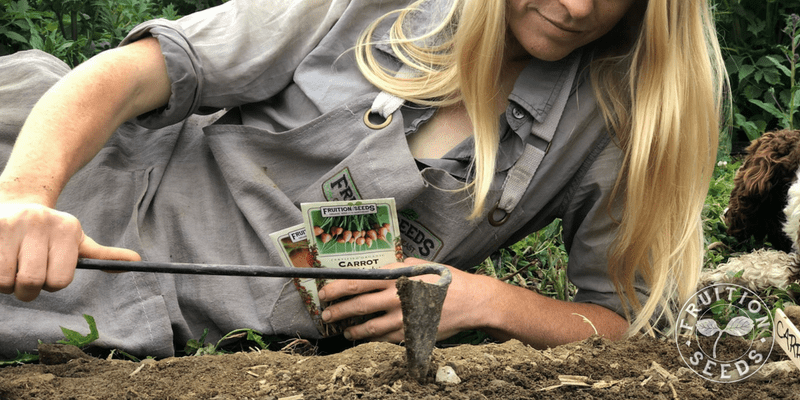
Rows have their advantages as well as their disadvantages. Many of my favorite garden mentors think outside the row & we do, too : )
Let There Be Light
As a general rule, all vegetables grow best in full sun. This is largely true for most flowers and herbs as well, especially if you plan to harvest them again and again.
Think of it this way: Leaves are the solar array of plants, allowing them to photosynthesize sugars from sunlight (this continues to *blow* my *mind* every time I think about it!) and so leafy plants like lettuce, kale and basil and grow better in partial sun than flowering/fruiting plants like tomatoes and zucchini.
How Do You Plan to Weed?
How you weed will dramatically impact how your garden is laid out. Weeding by hand, with a hand hoe (here is our favorite one from Japan), or standing with a hoe and applying mulch are the most common approaches (which can be combined) in an organic garden. Just make sure you have the space you need to weed between plants with your chosen method. There is a sweet (and often elusive) scenario where you weed diligently for the first month after seeding; once your plants are large enough, they’ll shade out weeds below while not competing with each other.
For heat-loving crops, we also use biotella, a biodegradable black material made of corn that feels quite like plastic. It effectively prevents weeds from growing and warms the soil as well as maintains moisture. Plants like tomatoes, peppers, eggplant, zucchini, cucumber, melon, and dahlias especially appreciate the extra warmth of biotella and thrive all the more with it.
Companion Planting
Adds an additional layer of depth, abundance and brilliance to your garden, hop on over here to explore Fruition’s Guide to Companion planting and enjoy!
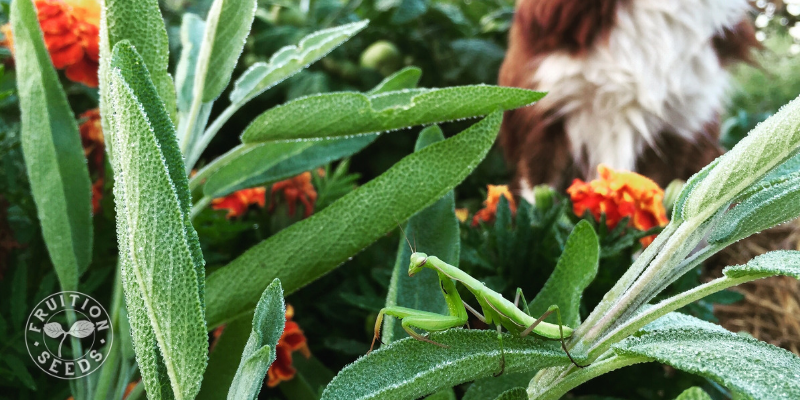
Many herbs make phenomenal companion plants, as well as our dwarf Queen Sophia marigolds and so many more! Enjoy our blog for our Guide to Companion Planting
How to Sow and Stick with It
Friends, it’s easy to plant a garden. It’s the weeding, watering, thinning and trellising and…and…and….that tends to slow enthusiastic gardeners early on and I’ve found that a few things really help to sweetly motivate me, may they do the same for you:
~ Garden with friends! And even if you aren’t literally gardening next to each other, share photos and stories, the joys and the doldrums, and tag Fruition Seeds (#WeAreFruition) in your social media so we can share it all with you, too!
~ Take notes and make them glorious! Whether you have a journal approach or are jotting notes in our perpetual calendar, documenting your observations and experiences allows you to look back as well as look forward with guidance. As years go by, emergent patterns will make it easy to adapt and amplify your abundance, which is why we named our perpetual calendar Across the Seasons. Combining garden notes (when we started sprouting our ginger!) with field notes (the Kingfisher returns!), here is a photo of what our first March is looking like on the calendar:
And here are the empty pages of April’s first half, so you can see more clearly the layout:
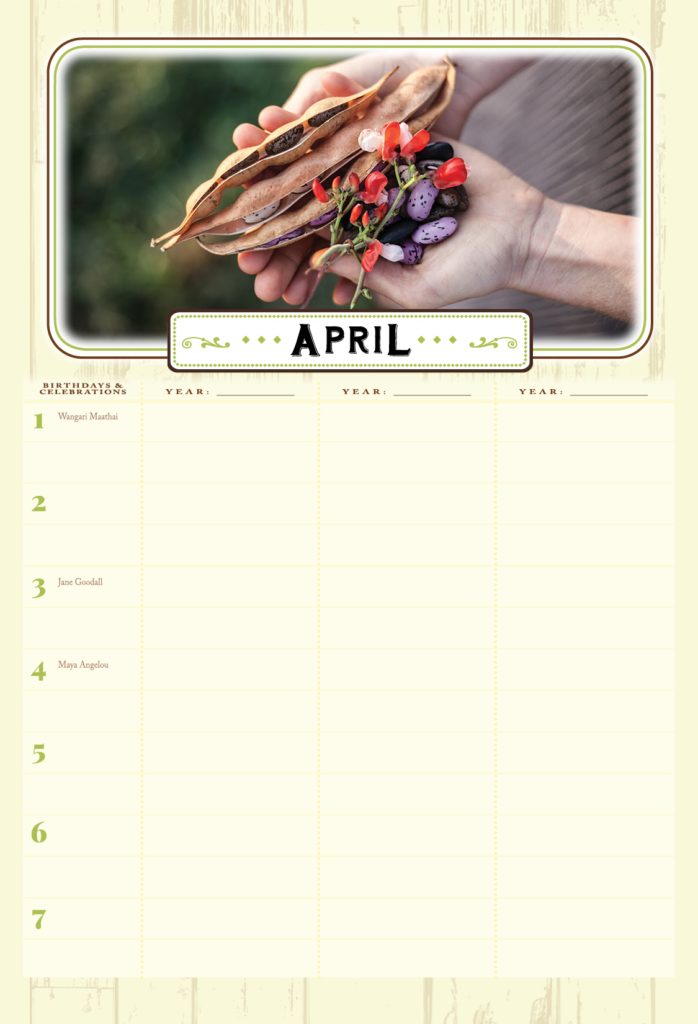
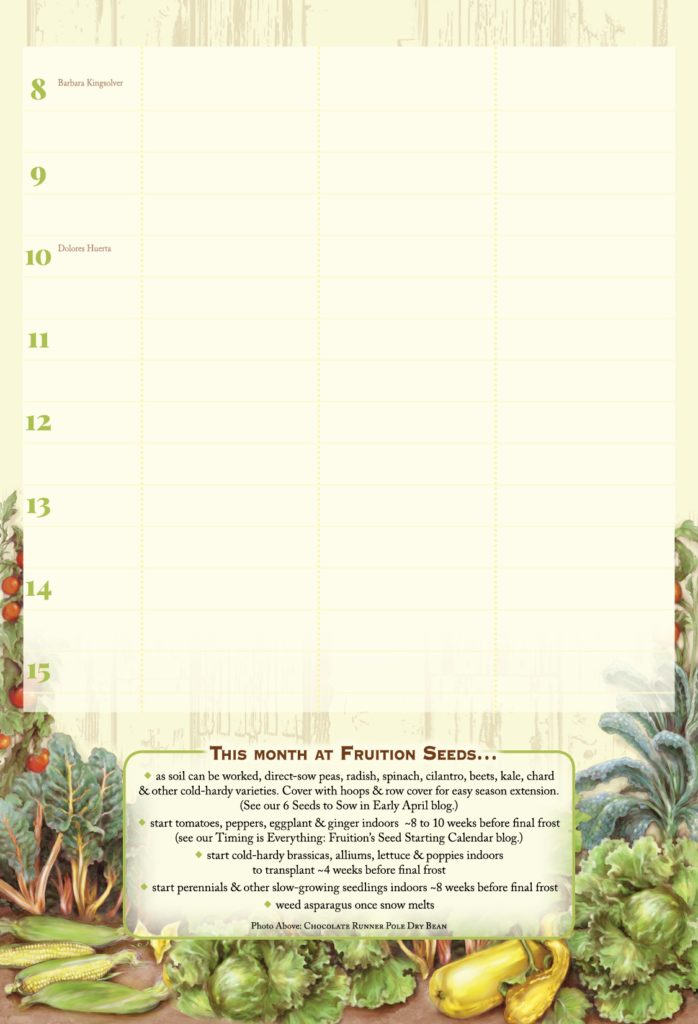
We’ve also a chart for your crop-specific notes so you can see at a glance all of your tomato observations, for example, instead of flipping through the pages of Across the Seasons to find all the relevant tomato notes. We love having the references of both the calendar and the crop notes, so Across the Seasons Calendar has several pages of crop notes at its end, as does our book Rise & Shine: Starting Seeds with Ease.
Here are the crop notes at the end of our Across the Seasons calendar:
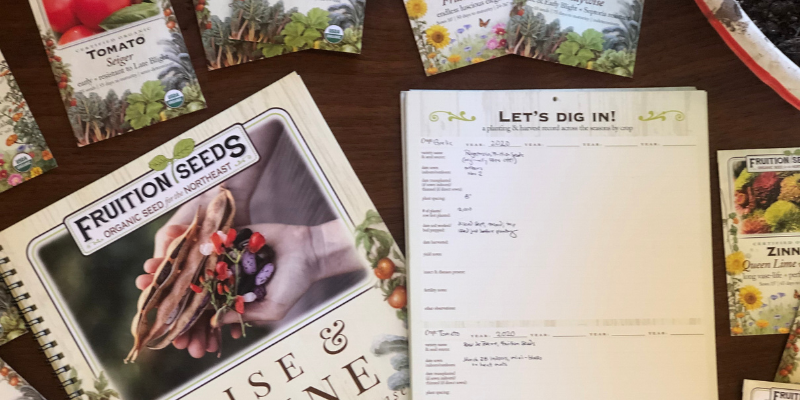
And here is the standalone crop notes page you can download here to print at home, if you wish:
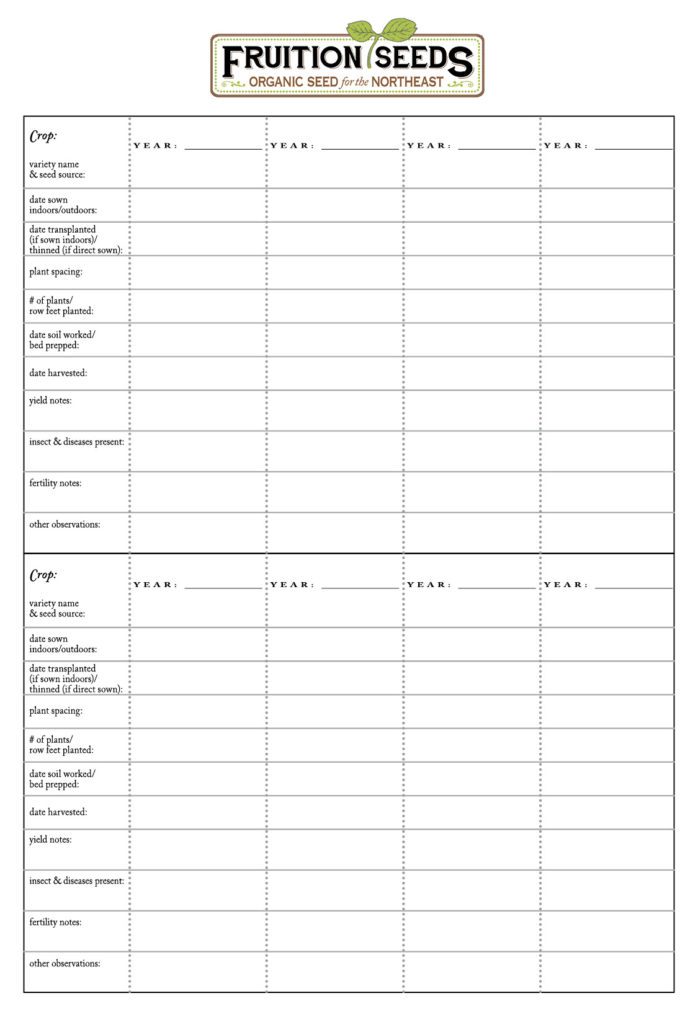
We love to share what we love with people we love!
Each season is unique, constantly changing, and so are each of us. Our gardens are reflections of everything we’ve experienced, learned and shared, everything we believe and dream. May they be abundant! May they be beautiful! May they feed so much more than our bodies, may they welcome us all to the table.
Hope you can join us at our table one day, as well…
…’til then!
Sow Seeds & Sing Songs,

and the Many Beings of Fruition

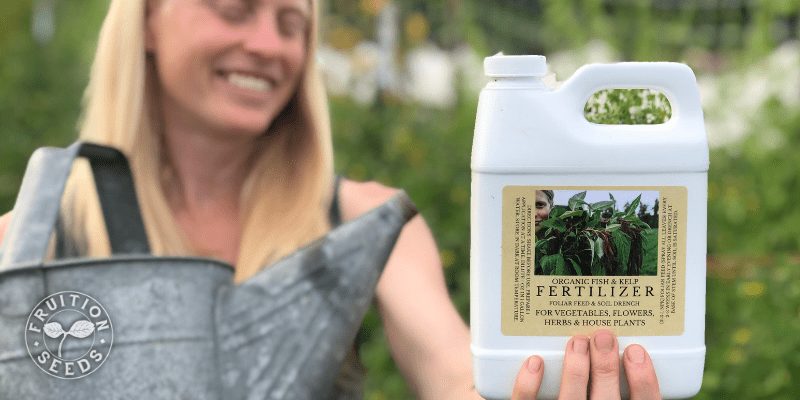
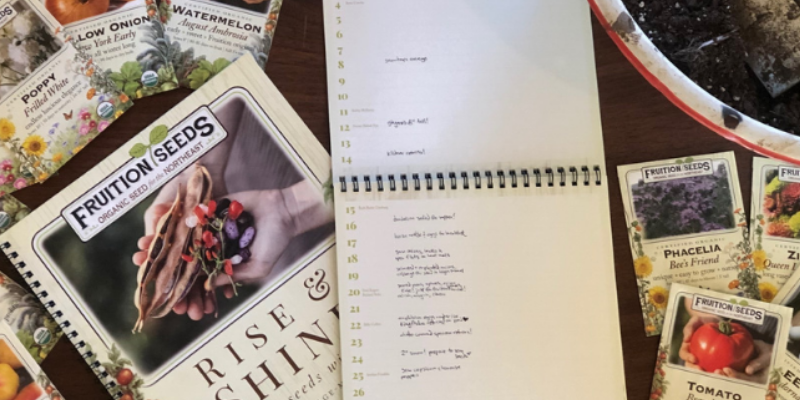
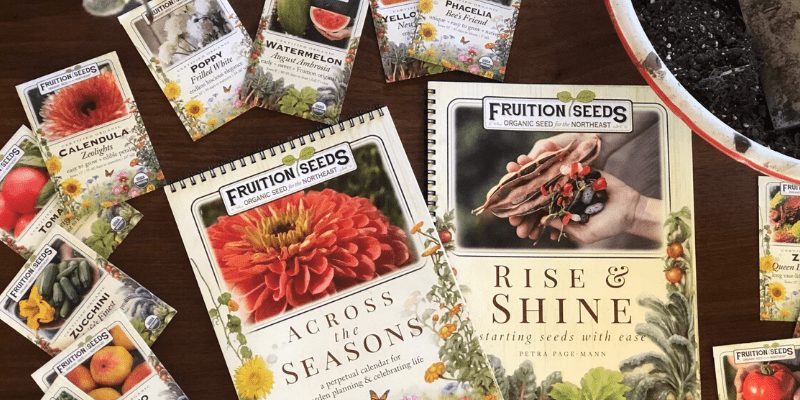
Thanks for getting back to me sending pictures for answers is good so hopefully in the future this can happen looking foreword to staying in touch and will be ordering at some point
Groundhog Greetings! I’m a bit behind, but I am trying to catch up. On the January page of the calendar, it refers to your “Easy Germination Testing at Home” blog, but I can’t find that. Will you please point me in the right direction?
Thanks for reaching out and apologies this was not easy to find. It looks like this blog did not carry over from our old website to our new website. We’re searching the archives and will let you know if we find it! In the meantime hop online to see what advice others are offering. Thank you for growing with us in all the ways~
this was a very helpful site. I came here for the charts. THANK YOU!